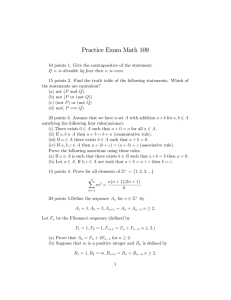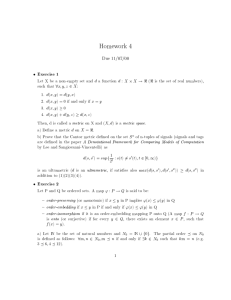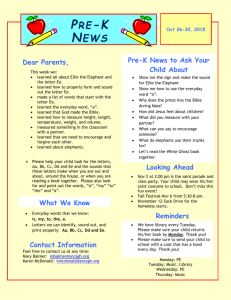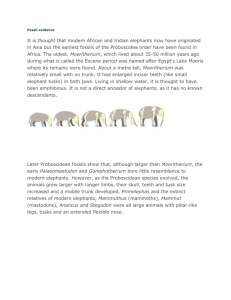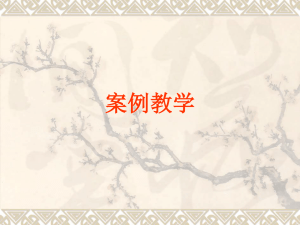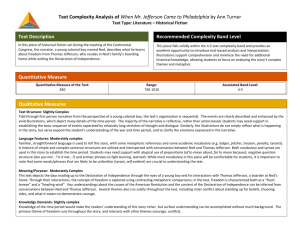Part 1
advertisement
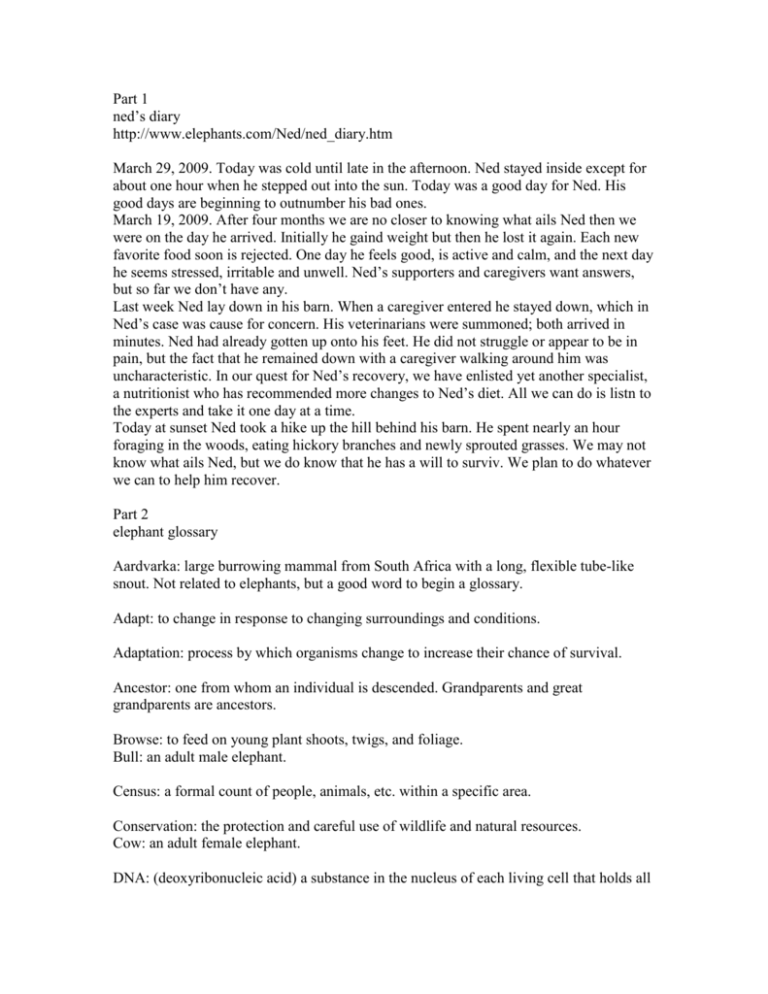
Part 1 ned’s diary http://www.elephants.com/Ned/ned_diary.htm March 29, 2009. Today was cold until late in the afternoon. Ned stayed inside except for about one hour when he stepped out into the sun. Today was a good day for Ned. His good days are beginning to outnumber his bad ones. March 19, 2009. After four months we are no closer to knowing what ails Ned then we were on the day he arrived. Initially he gaind weight but then he lost it again. Each new favorite food soon is rejected. One day he feels good, is active and calm, and the next day he seems stressed, irritable and unwell. Ned’s supporters and caregivers want answers, but so far we don’t have any. Last week Ned lay down in his barn. When a caregiver entered he stayed down, which in Ned’s case was cause for concern. His veterinarians were summoned; both arrived in minutes. Ned had already gotten up onto his feet. He did not struggle or appear to be in pain, but the fact that he remained down with a caregiver walking around him was uncharacteristic. In our quest for Ned’s recovery, we have enlisted yet another specialist, a nutritionist who has recommended more changes to Ned’s diet. All we can do is listn to the experts and take it one day at a time. Today at sunset Ned took a hike up the hill behind his barn. He spent nearly an hour foraging in the woods, eating hickory branches and newly sprouted grasses. We may not know what ails Ned, but we do know that he has a will to surviv. We plan to do whatever we can to help him recover. Part 2 elephant glossary Aardvarka: large burrowing mammal from South Africa with a long, flexible tube-like snout. Not related to elephants, but a good word to begin a glossary. Adapt: to change in response to changing surroundings and conditions. Adaptation: process by which organisms change to increase their chance of survival. Ancestor: one from whom an individual is descended. Grandparents and great grandparents are ancestors. Browse: to feed on young plant shoots, twigs, and foliage. Bull: an adult male elephant. Census: a formal count of people, animals, etc. within a specific area. Conservation: the protection and careful use of wildlife and natural resources. Cow: an adult female elephant. DNA: (deoxyribonucleic acid) a substance in the nucleus of each living cell that holds all the inherited characteristics of an organism. Domestic: living with or under the care of human beings; tame. Ecosystem: a community consisting of plants, animals, other organisms, and physical features considered as a unit. Endangere: a group of living things (plants or animals) that may die out if protective measures are not taken. Extinct: a species that no longer exists anywhere on the earth. The wooley mammoth is extinct. Gestation: the period of development of a mammal embryo inside the mother’s womb; the time between fertilization of the egg and birth of the fetus. graze : to eat grass and other low-growing plants. Habitat: the place where a plant grows naturally or an animal usually lives in the wild. habitat loss: the destruction or alteration of an area that makes it unsuitable for the species that once lived there. Herbivore: any animal that feeds only on plant materials. Elephants are herbivores. Herd: a group of animals that feed and live together in the wild. Ice Age: one of several long, cold periods in the history of the earth when glaciers covered large parts of the northern hemisphere. Ivory: the hard, white material which makes up the tusks of elephants, walruses, mammoths. Mammal: a warm-blooded animal with a backbone. Mammals generally have body hair at some stage in their lives, have a well-developed brain, a four-chamber heart, and females feed offspring with milk from mammary glands. Humans, elephants, dogs, and cats are mammals. Mammoth: a very large, hairy elephant relative with curved tusks which became extinct about 10,000 years ago. Manatee: a large marine mammal, also called a sea cow; related to elephants and mammoths. Matriarch: oldest female in a family unit; leader of the group. Migrate: to pass from one region to another on a regular basis, usually to feed or breed. Moeritherium: (meer-uh-THEER-ee-um) pig-sized prehistoric mammal from which elephants are descended; elephant ancestors. Omnivore: an animal that eats both plants and meat. Humans are omnivores. Pachyderm: any of several large, thick-skinned animals such as elephant, rhinoceros, hippopotamus. Physiology: the internal working of a living body and its parts (cells and organs). Poaching: hunting or fishing illegally. Population: the total number of members of a species living in a particular area at any one time. Sanctuary: a place of safety and protection. Species: a unit of classification in animals and plants. Members of the same species can mate and produce fertile offspring. Threatened: a species that is in decline and may become endangered or extinct if it is not protected. Trunk: the long, flexible combination of nose and upper lip found on elephants. Tusk: an enlarged upper incisor that grows outside the mouth of certain animals. Ungulate: a hoofed mammal such as elephant, horse, cattle, deer, etc. Vegetation: all plant life. Vertebrate: any animal that has a skeleton of bone or cartilage with a backbone, skull, and well-developed brain. Zoology: scientific study of all forms of animal life.
